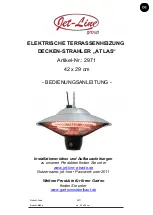
3
Dutchwest
®
Non-Catalytic Convection Heater
30003851
Creosote is a by-product of low-temperature stove
operation, weak draft, or both. It is a tar that results
when unburned gases condense inside the flue sys-
tem at temperatures below 143° C (90˚ F). Creosote
is volatile and can generate a chimney fire. All of the
installation characteristics that adversely affect chimney
draft also promote creosote condensation. Conse-
quently, you can minimize creosote accumulation with
an effective chimney design and the use of operational
techniques that encourage good draft and complete
combustion.
Inspect your chimney frequently and clean it whenever
accumulation exceeds 6 mm (1/4”).
Backpuffing
Backpuffing is a condition that results when the draft is
too weak to pull flue gases out of the chimney system
as fast as the fire generates them. Volatile gases build
up within the firebox until reaching a density and tem-
perature at which they ignite. With this ignition, you may
hear a muffled popping sound and see a bit of smoke
forced out of the stove.
This condition is most likely to occur in the Spring or
Fall when moderate outdoor temperatures and low
intensity fires produce weak draft. If your stove back-
puffs, open the damper to let the smoke rise to the flue
more quickly. Also, open the air inlets to induce a livelier
fire and speed airflow through the stove. Avoid large
loads of firewood at one time. You should always see
lively, dancing flames in the firebox; a lazy, smoky fire is
inefficient and will promote draft problems.
Draft Testing
An easy way to determine whether your chimney draft
is strong enough is to close the stove damper, wait a
few minutes to let the airflow stabilize, and then test
whether you can vary the strength of the fire by swing-
ing the air control open and closed. Results here are
not instant; you may need to wait a few minutes for a
change in the air control setting to have an effect on
the fire. If there is no change, the draft is not yet strong
enough to let you close the damper. You will need to
open it for a while longer and manage the fire with the
air inlet until the draft strengthens.
Keep a record of your operating habits and relate them
to their effects on the stove’s function. You’ll be reward-
ed with safe and efficient performance.
Negative Pressure
Good draft also depends on a sufficient supply of air
to the stove. The chimney can’t pull in more air than is
available to it. Sluggish draft can be caused by a house
that is tight enough to prevent the ready flow of air to
the stove, or by competition between the stove and
other appliances that vent indoor air to the outside; i.e.,
exhaust fans for range hoods, clothes dryers, bathroom
fans, etc.
If the chimney draws well when all such equipment is
turned off (or sealed, in the case of fireplaces and/or
other stoves), you need to be attentive in timing the use
of the other appliances. If you need to crack a nearby
window or door to enable the chimney to pull well, you
should install an outside-air intake to bring combustion
air into the room.
In many cases, local or national codes require the
installation of permanently open air vents, particulary
with larger appliances (i.e. above 5 kW). Refer to these
codes to determine specific requirements for your
installation.
Conclusion
Woodburning is more an art than a science. Art in-
cludes technique; and since installations, homes, and
fuel vary, the stove operator must also vary technique,
(mostly timing), to achieve satisfying results. Over time,
you will become familiar with the features of your par-
ticular installation; you will be able to identify cause and
effect in a variety of seasonal circumstances, and adapt
your operating habits to changing conditions.






































